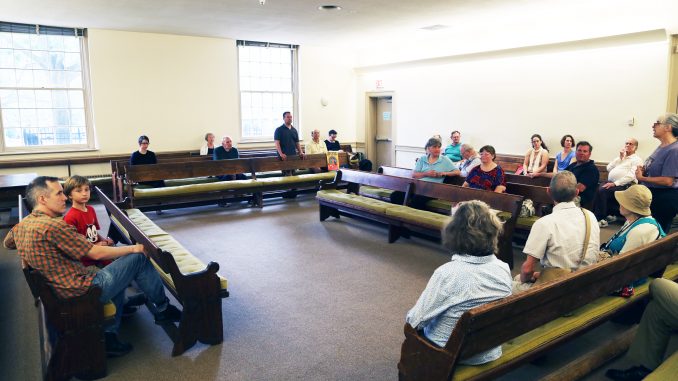
Lynne Calamia wore jeans, drank Starbucks and completely defied the general perception of a Quaker.
As the director of Arch Street Meeting House, she often hears the common misconceptions that are attributed to the image of Quakers, an image that has remained somewhat stagnant for the past 200 years.
“No, we are not Pilgrims,” Calamia said jokingly.
By definition, a Quaker is an active faith-based community member that continues traditional testimonies of pacifism, social equality, integrity and simplicity.
Although the community has changed, its building has preserved its historical architecture, making it a tourist attraction in Old City. With an intake of about 27,000 tourists per year, Arch Street Meeting House acts as a hub for Quaker history.
“This building is special because it has a giant capacity, because of where it’s located, and now it’s taking on the character of a historic site – it’s like an outreach tool,” Calamia said.
Built in 1804, the building contains immense history and tells the story of Quakers in Philadelphia that still continues today.
“Everyone who comes here learns about Quakerism in the Quaker city,” Calamia said.
Arch Street is one of the seven meeting houses in Philadelphia, a city that holds the greatest concentration of Quakers in America. However, while the building attracts thousands of visitors, the community still lacks in a younger population.
“There’s a joke that the median age of a Quaker is 81,” Calamia said.
Though the community consists of an older population, Calamia said she thinks it still has benefits to offer younger people.
After each weekly service, the community gathers for a coffee hour, a social gathering after service to discuss topics ranging from personal anecdotes to political issues. When asked about the nature of the meeting, a few members compared Quakerism to Buddhism as meditation acts as a core practice.
“You need to train in order to be silent with your own thoughts, and then you get to train to let your own thoughts go and see what else is out there,” said Dorothy Berlind, a 75-year-old member of Arch Street and longtime resident of Philadelphia.
She laughed as she referred to the underlying thoughts as “subconscious gossiping.”
The meetings consist of an hour of silence in which the members meditate and potentially feel what members call “the Light.” The Light can mean different things to the members. For some, it is God. For others, it can be the universe. If a member feels compelled, he or she can stand and make a statement about something that comes up in the contemplation.
“Quakers go under the belief that you decide internally, you yourself develop your relationship with God,” Mignon Adams, a member of Arch Street for 27 years, said.
Though the community might differ in beliefs, it is united on the principles of simplicity, equality and unity. Kindness toward others is one of the most valued and most evident principles.
However, humble and kind does not mean passive.
“There’s an incredible amount of history that Quakers have – the first suffragists, the first abolitionists, the first civil rights leaders… They’re just incredible movers and shakers throughout history,” Calamia said.
Arch Street Meeting House itself served as a stop in the Underground Railroad.
Calamia recalled the day that hundreds of Quakers showed up to the Meeting House with brooms as an act of protest against Keystone XL extension, the controversial proposal regarding the pipeline that runs from Canada to the U.S.
The Quakers brought brooms to the Philadelphia Federal Building to “sweep out injustice.”
Quakerism, as a religion, Calamia said, can apply to many people’s practices and beliefs, but most people aren’t informed.
“Sometimes you see it click in their heads,” Calamia said. “They realize they’ve been Quakers all along and they just didn’t know what the word was.”
Tara Doherty tara.doherty@temple.edu


Be the first to comment